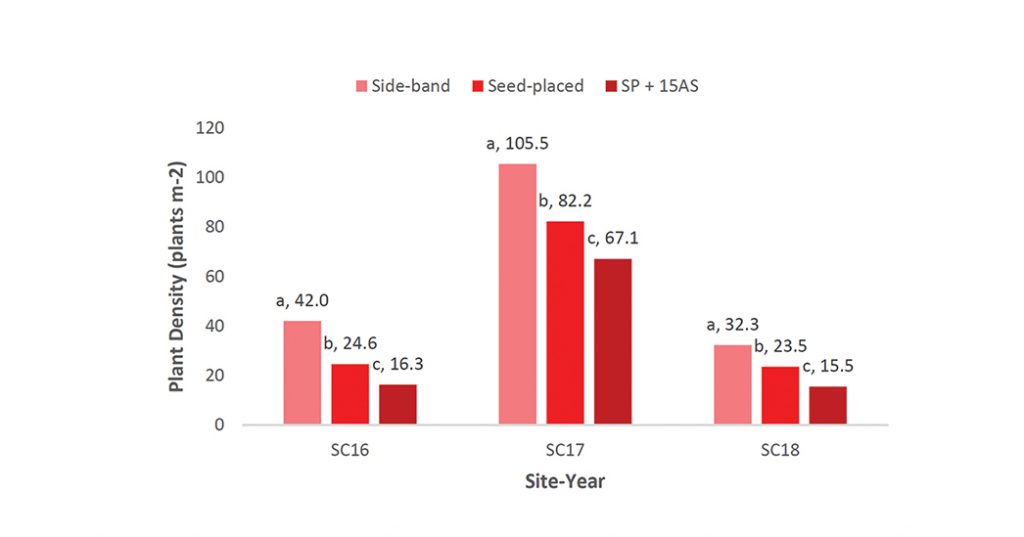Key Result
Placing phosphate fertilizer in the seed row has its challenges because seed damage can occur at fairly low rates. Rather than short the crop with a low seed-placed rate, this study found that the full recommended rate placed outside the seed row is the better option.
Project Summary
This study shows promise for placing all phosphate fertilizer outside the seed row versus in the seed row, especially at rates required to meet canola’s season-long demand for the nutrient.
Most soils in Saskatchewan are deficient in available phosphate (P2O5) and this macronutrient typically limits crop growth and yield. (Average available phosphate levels in Alberta and Manitoba are slightly higher, but not much.) Furthermore, canola has a relatively high phosphate requirement compared to cereals. With the ever-increasing yield potential of newer canola hybrids, phosphate nutrition in this crop is crucial to ensure that yield potentials are optimized.
Phosphate is relatively immobile, so placement of the fertilizer can influence when and how the crop can use it. The common recommendation for canola is to band fertilizer phosphate in the seed-row, but high seed-placed rates can reduce emergence. Fertilizer damage to canola seedlings and stand establishment has been shown in various recent studies, including this one. This study took the research a step further to see how modern hybrids could perform with all phosphate placed outside the seed row.
The trial was designed as a two-factor factorial with treatments arranged in a four-replicate randomized complete block design. The first factor was five fertilizer P2O5 rates ranging from 0, 20, 40, 60, and 80 kilograms per hectare. (20 kg/ha is around 18 lb./ac.) The second factor was placement, which compared side-band, seed-placed, and seed-placed in combination with ammonium sulphate (at a fixed 15 kg/ha rate). Small plot trials were established at Indian Head, Melfort and Scott, Saskatchewan over a three-year period (2016 to 2018).
Figure 1. Phosphorus placement effect on plant density

Results of this research showed damage to canola stand establishment even from very low rates of seed-placed phosphate, but the level of damage was not as severe as with previous studies. Researchers wonder if that’s the result of using a hoe-type opener, which has higher seed-bed utilization (and thus improved seed safety from fertilizer), instead of disc opener. However, researchers found that predicting the degree of damage caused by seed-placed fertilizer is very difficult as it is influenced by other factors such as soil texture, soil organic matter and moisture. Since these factors vary considerably across most fields, damage can be quite variable across the various landscape positions. Furthermore, even adding a small amount of ammonium sulphate to P in the seed-row can increase damage to seeds and reduce canola emergence. Therefore, this practice should be discouraged.
Overall, the researchers found no evidence of better responses associated with seed-placed P over side-band P, even at low rates, and that high rates of side-banded P are always equal to or greater than seed-placed. This was true for stand establishment and yield.
Yield improved with higher phosphorus rates in general, and in some cases, were found to be even greater with side band treatments, especially at higher rates. Optimal canola yields were reached between 70 and 80 kg/ha of fertilizer P. Therefore, if high rates of phosphorus are required, fertilizer P should be side-banded to minimize seed damage and maximize yields as it was the most consistent and beneficial application method. Due to minimized seed damage, the high plant populations achieved as a result of side banding can provide the added benefit of reduced days to maturity, which will lower green seed risk.
The researchers conclude that the optimal phosphorus management practices have changed for growing canola in Saskatchewan, and that all or most of the phosphorus fertilizer applied should be side-banded, especially when higher rates are needed.





